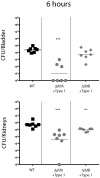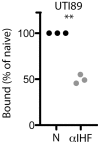Aberrant community architecture and attenuated persistence of uropathogenic Escherichia coli in the absence of individual IHF subunits
- PMID: 23133584
- PMCID: PMC3485042
- DOI: 10.1371/journal.pone.0048349
Aberrant community architecture and attenuated persistence of uropathogenic Escherichia coli in the absence of individual IHF subunits
Abstract
Uropathogenic Escherichia coli (UPEC) utilizes a complex community-based developmental pathway for growth within superficial epithelial cells of the bladder during cystitis. Extracellular DNA (eDNA) is a common matrix component of organized bacterial communities. Integration host factor (IHF) is a heterodimeric protein that binds to double-stranded DNA and produces a hairpin bend. IHF-dependent DNA architectural changes act both intrabacterially and extrabacterially to regulate gene expression and community stability, respectively. We demonstrate that both IHF subunits are required for efficient colonization of the bladder, but are dispensable for early colonization of the kidney. The community architecture of the intracellular bacterial communities (IBCs) is quantitatively different in the absence of either IhfA or IhfB in the murine model for human urinary tract infection (UTI). Restoration of Type 1 pili by ectopic production does not restore colonization in the absence of IhfA, but partially compensates in the absence of IhfB. Furthermore, we describe a binding site for IHF that is upstream of the operon that encodes for the P-pilus. Taken together, these data suggest that both IHF and its constituent subunits (independent of the heterodimer), are able to participate in multiple aspects of the UPEC pathogenic lifestyle, and may have utility as a target for treatment of bacterial cystitis.
Conflict of interest statement
Figures









Similar articles
-
Metabolic Requirements of Escherichia coli in Intracellular Bacterial Communities during Urinary Tract Infection Pathogenesis.mBio. 2016 Apr 12;7(2):e00104-16. doi: 10.1128/mBio.00104-16. mBio. 2016. PMID: 27073089 Free PMC article.
-
Kinetics of uropathogenic Escherichia coli metapopulation movement during urinary tract infection.mBio. 2012 Feb 7;3(1):e00303-11. doi: 10.1128/mBio.00303-11. Print 2012. mBio. 2012. PMID: 22318320 Free PMC article.
-
Maturation of intracellular Escherichia coli communities requires SurA.Infect Immun. 2006 Aug;74(8):4793-800. doi: 10.1128/IAI.00355-06. Infect Immun. 2006. PMID: 16861667 Free PMC article.
-
Bacterial characteristics of importance for recurrent urinary tract infections caused by Escherichia coli.Dan Med Bull. 2011 Apr;58(4):B4187. Dan Med Bull. 2011. PMID: 21466767 Review.
-
Host-pathogen checkpoints and population bottlenecks in persistent and intracellular uropathogenic Escherichia coli bladder infection.FEMS Microbiol Rev. 2012 May;36(3):616-48. doi: 10.1111/j.1574-6976.2012.00339.x. FEMS Microbiol Rev. 2012. PMID: 22404313 Free PMC article. Review.
Cited by
-
The role of integration host factor in biofilm and virulence of high-alcohol-producing Klebsiella pneumoniae.Microbiol Spectr. 2023 Sep 21;11(5):e0117023. doi: 10.1128/spectrum.01170-23. Online ahead of print. Microbiol Spectr. 2023. PMID: 37732783 Free PMC article.
-
Association of O-Antigen Serotype with the Magnitude of Initial Systemic Cytokine Responses and Persistence in the Urinary Tract.J Bacteriol. 2016 Jan 11;198(6):964-72. doi: 10.1128/JB.00664-15. J Bacteriol. 2016. PMID: 26755631 Free PMC article.
-
Antimicrobial resistance and mechanisms of epigenetic regulation.Front Cell Infect Microbiol. 2023 Jun 14;13:1199646. doi: 10.3389/fcimb.2023.1199646. eCollection 2023. Front Cell Infect Microbiol. 2023. PMID: 37389209 Free PMC article. Review.
-
The DNABII family of proteins is comprised of the only nucleoid associated proteins required for nontypeable Haemophilus influenzae biofilm structure.Microbiologyopen. 2018 Jun;7(3):e00563. doi: 10.1002/mbo3.563. Epub 2017 Dec 12. Microbiologyopen. 2018. PMID: 29230970 Free PMC article.
-
A bacterial-biofilm-induced oral osteolytic infection can be successfully treated by immuno-targeting an extracellular nucleoid-associated protein.Mol Oral Microbiol. 2017 Feb;32(1):74-88. doi: 10.1111/omi.12155. Epub 2016 Apr 5. Mol Oral Microbiol. 2017. PMID: 26931773 Free PMC article.
References
-
- Foxman B (2010) The epidemiology of urinary tract infection. Nature reviews Urology 7: 653–660. - PubMed
-
- Justice SS, Hung C, Theriot JA, Fletcher DA, Anderson GG, et al. (2004) From the cover: Differentiation and developmental pathways of uropathogenic Escherichia coli in urinary tract pathogenesis. Proceedings of the National Academy of Sciences of the United States of America 101: 1333–1338. - PMC - PubMed
-
- Mulvey MA, Lopez-Boado YS, Wilson CL, Roth R, Parks WC, et al. (1998) Induction and evasion of host defenses by type 1-piliated uropathogenic Escherichia coli . Science 282: 1494–1497. - PubMed
-
- Anderson GG, Palermo JJ, Schilling JD, Roth R, Heuser J, et al. (2003) Intracellular bacterial biofilm-like pods in urinary tract infections. Science 301: 105–107. - PubMed
-
- Bishop BL, Duncan MJ, Song J, Li G, Zaas D, et al. (2007) Cyclic AMP-regulated exocytosis of Escherichia coli from infected bladder epithelial cells. Nat Med 13: 625–630. - PubMed
Publication types
MeSH terms
Substances
Grants and funding
LinkOut - more resources
Full Text Sources
Other Literature Sources

